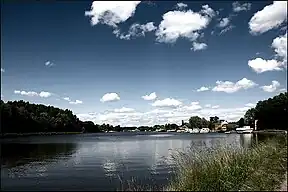Sensée Canal
The Canal de la Sensée (French pronunciation: [kanal də la sɑ̃se]) is a canal in northern France. The project was developed under Napoleon. In March 1806, the imperial government gave orders to build a canal which would link the Scarpe River and the Escaut River (English: Scheldt). The work was commenced under the direction of Augustin Honnorez in June 1819 and the Sensée canal was opened to navigation in November 1820. At that time the boats were pulled by men or horses working for boat employers. Shortly after World War I 1914-1918, horses were replaced by tractors.
| Canal de la Sensée | |
|---|---|
 The Bassin Rond - a small artificial lake where the Escaut end the Canal de la Sensée meet near Estrun | |
| Specifications | |
| Length | 25 km (16 mi)[1] |
| History | |
| Current owner | VNF |
| Principal engineer | Augustin Honnorez |
| Date approved | 1806 |
| Construction began | 1819 |
| Date completed | 1820 |
| Geography | |
| Start point | Scarpe near Douai[2] |
| End point | Scheldt in Hordain[2] |
| Beginning coordinates | 50.3395°N 3.0534°E |
The Canal de la Sensée forms part of the Canal Dunkerque-Escaut route.
See also
References
- McKnight, Hugh (2005). Cruising French Waterways, 4th Edition. Sheridan House. ISBN 9781574092103.
- Fluviacarte, Canal à Grand Gabarit (liaison Dunkerque-Escaut)
External links
- Project Babel
- Ecoleslanoy.free.fr
- Map
- Grand Gabarit guide Places, ports and moorings on the canal(s).
This article is issued from Wikipedia. The text is licensed under Creative Commons - Attribution - Sharealike. Additional terms may apply for the media files.